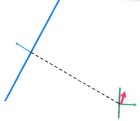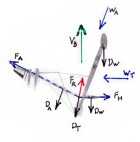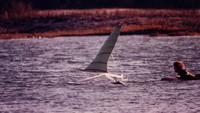High-Speed Sailing
| Vessel Name: | Sailien |
| Vessel Make/Model: | Experimental/custom |
28 September 2013
The America’s Cup
I watched, with interest, the videos of the 34th America’s Cup. At last we have fast sailboats engaged in a competition that is fun to watch. The virtual images (such as course boundaries, distance grid lines, separation between boats, etc.) overlaid on the real images really helps to keep the race [...]
31 August 2013
100 Knots for Hydroptere?
The latest news from Hydroptere is that they have plans for a 100 knot sailboat. This was posted on 26 Aug 2013, so look for that date at this address. http://hydroptere.com/en/the-news/last-news/
17 November 2012
Aptly named Sailrocket, blasts off!
While yet to be ratified, Sailrocket posted an average speed over 500 meters of 59 knots. I will not be surprised if they increase their record into the 60 knot range during this record attempt.
02 January 2012
More drag for VSR2?
I want to start by pointing out that the whole VSR2 team has done a stellar job and has demonstrated conclusively that the forces that drive a sailboat can be aligned for roll stability without using ballast and without using any down-force. (Trifoiler achieved roll stability by using down-force, but [...]
18 December 2011
My analysis of Sailrocket
I copied a diagram of VSR2 (wing doesn’t show well) and added in the major force arrows that apply. Be aware that these arrows are not correct in terms of scale (length) and some of their locations are guesses, however I believe I’m correct enough for us to learn something about what VSR2 has been [...]
23 October 2011
60 is within reach, what’s next?
I have been watching Sailrocket’s progress with great interest and there’s no question they have a winner. I fully expect to see them reach 60kt in the near future. Sailrocket has now demonstrated what I first learned with my models and again with my full-sized prototypes, that if you get the forces [...]
Jules Verne Trophy
What really becomes clear in following this race is how dependent success is on the weather. You can have the fastest craft but without wind, you're not moving. The ideal craft for a circumnavigation of the globe will be one that is very efficient in light winds, and tough enough to sail fast in rough, windy conditions. It looks like Groupama 3 got that combination right. The rest of the equation is weather and of course "luck". A good weather router is essential to finding the best route to sail under constantly changing conditions and of course, you need to be lucky enough to not hit some trash, a rouge wave, etc.
The wind variability got me looking at that universal sailing problem. We can see that the wind can be likened to the fuel that propels the craft, and our sail/keel combination as the engine that converts the wind's energy into our craft's motion. Without any fuel (wind) no sailboat moves, but once there is wind, the most efficient craft moves the fastest. Note that the most efficient craft is not necessarily the one with the biggest "motor" but rather the one with the best power to drag ratio. High-speed sailing is really an exercise in efficiency (and stability as I've been pointing out earlier). Modern materials and fluid dynamics have led to the recent large increases in sailing speed, by enabling us to make more efficient craft.
Bob
About & Links
- Bob's Surfing Blog
- Bob's Website
- Greenbird (Windjet)
- l'Hydroptere
- Le Projet Dared
- Macquarie Speed Sailing Team
- Monofoil Sailing
- Mountain Goat STOL
- Mr Smith's Amazing Sailboats
- Patent Office (Search)
- Radboat
- Sailien Prototypes (early), Delta, etc.
- Sailien Video
- Sailien Website
- The Basics of Surfboard Design
- The Basics of Surfboard Design en Espanol
- The Swedish Speed-Sailing Challenge
- Trifoiler
- Vestas Sailrocket
- Windjet Project
- WSSRC


